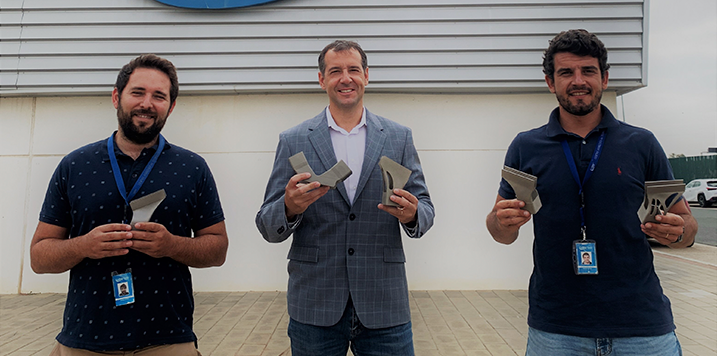 15 September, 2021
15 September, 2021Eutelsat Quantum, a commercial satellite built by Airbus in collaboration with the European Space Agency (ESA) and Eutelsat, is scheduled to launch on July 30. A satellite that incorporates parts designed and manufactured by the Advanced Center for Aerospace Technologies, Catec, through 3D printing.
In collaboration with Airbus, Catec has manufactured several of the parts that will soon reach space on the Eutelsat Quantum satellite. Specifically, it is about the supports of the titanium solar panels, applying 3D printing technology or also called additive manufacturing. These pieces were developed and delivered by the Catec in 2016, at that time one of the first manufactured by technology of a critical nature from a structural and functional point of view, fully qualified for space. This development process has required extensive knowledge of technology and maturity, where all associated processes have had to be qualified, from the storage and monitoring of the raw material, the application of post-processes such as heat treatments, improvement of the surface finish, machining of the interfaces, and finally the methods of verification and non-destructive qualification, resorting in this house to X-ray computed tomography.
Additive manufacturing is precisely one of the main lines of activity and specialization of the Andalusian technology center, in which it has been working for more than a decade, when this technology was still emerging. 3D printing is one of the processes that brings the greatest benefits to the space sector, in which the reduction of weight, manufacturing times and costs are important.
Fernando Lasagni, technical director of Materials and Processes of Cate (center), accompanied by Antonio Perin (right) and Carlos Galleguillos (left) with the manufactured parts.
All these years of experience and research has served Catec to develop more than 100 aerospace applications for launchers, satellites and space probes. In addition to the Quantum satellite, to highlight other recent milestones, it has developed a critical framework for the Cheops satellite (in collaboration with the engineering company CiTD) and the PROBA-3 mission (together with Sener), both from ESA. Also in collaboration with the European Space Agency, CiTD and Airbus, Catec has recently delivered part of the secondary structure of the Juice space probe (JUpiter ICy moons Explorer), which will study the cold moons of Jupiter.
Fernando Lasagni, Technical Director of Materials and Processes at Catec, leads the team of engineers and researchers working on various technologies related to Industry 4.0 for the aerospace sector: the upcoming launch of the Eutelsat Quantum satellite will culminate a new milestone for Catec, and for thus for the Andalusian and Spanish aerospace sectors, demonstrating that we are at the forefront of additive manufacturing technology in Europe and the world, developing without complexes all kinds of projects for the aerospace sector. This is the result of many years of work and commitment, and of an experienced team of engineers in additive manufacturing and related processes, such as Antonio Perin, Carlos Galleguillos, among many other colleagues at Catec.
Subscribe to our newsletter. Just insert your e-mail and you will receive the latest news.